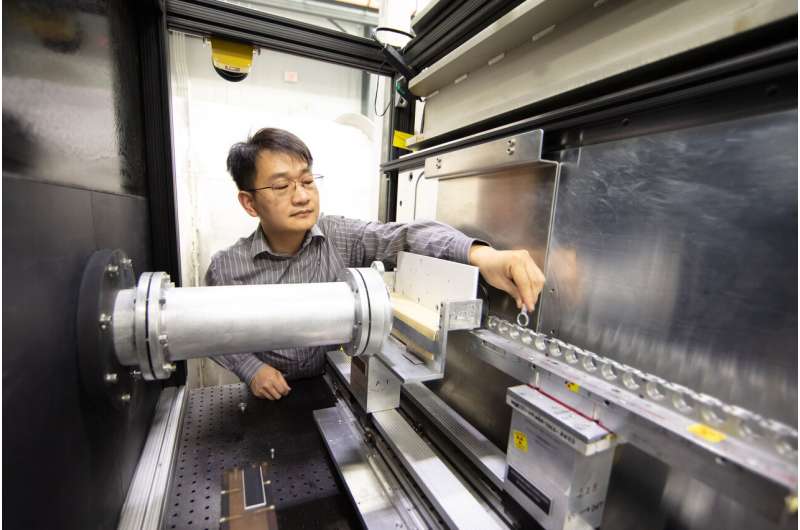Self-assembly required: Neutrons probe novel polymer behavior for biomedical materials

A versatile class of flexible, protein-like polymers could significantly advance future drug delivery methods. But first, scientists have to develop a reliable process for tailoring these polymers into shapes that can effectively transport medicines throughout the human body.
Donghui Zhang, a professor of chemistry at Louisiana State University, is at the Department of Energy's (DOE's) Oak Ridge National Laboratory (ORNL) to solve this problem. Her goal is to learn more about crystallization-driven self-assembly, a technique for forming nanoscale solid materials from polymeric solutions. Specifically, she wants to better understand how this technique could be used to craft controlled-shape nanostructures from polymers known as polypeptoids. These polymers are particularly good at navigating the human body's complicated ecosystem, and if Zhang can find an effective way to mold them into task-specific structures, she may be able to give engineers and other researchers better access to an exciting new material. Her research is published in the journal Macromolecules.
"We know it's possible to create these nanostructures from polypeptoids, but there are many aspects of this process that remain poorly understood. We'd like to learn more about it so other scientists can access these materials more easily," said Zhang.
Zhang explains that crystallization-driven self-assembly describes a process in which polymers dissolved in solution slowly assemble themselves into more rigid nanoscopic structures as that solution is cooled below its crystallization point. Depending on the exact shape and dimensions of these crystallized structures, they can then be used to accomplish a number of medical missions involving things like drug encapsulation and the slow release of medication into the bloodstream.
"These polymers can assemble themselves into a wide variety of shapes. Fibers, rods, and two-dimensional sheets are all possible outcomes from crystallization-driven self-assembly, and each of these shapes can be used to serve a different purpose," said Zhang.
The problem, she explains, is predicting exactly which shapes will appear once the polymer crystallizes in solution. Some shapes are more valuable than others. In particular, nanorods and one-dimensional nanofibrils crafted from polypeptoids are excellent vehicles for certain anti-cancer medications and can survive in the bloodstream for long periods of time. Zhang wants to better understand the mechanisms behind crystallization-driven self-assembly so she can hone the process and produce these useful shapes with greater regularity.
"To maximize the effectiveness of this material, we need to ensure that it possesses a tailorable morphology, meaning it has to be something we can synthesize into specific shapes and sizes," said Zhang.
To learn more about crystallization-driven self-assembly and how it might be used to produce tailored nanostructures from polypeptoids, Zhang used a combination of neutron and X-ray scattering to study polypeptoid samples suspended in solution.
Zhang was provided resources to DOE's ORNL and Brookhaven National Laboratory (BNL) through a new joint access program for small angle neutron scattering (SANS) and small angle X-ray scattering (SAXS). The program greatly expedites the research process and increases the speed in which scientists can publish their discoveries by allowing them to request beam time at both facilities through a single proposal—with access to the Bio-SANS instrument at ORNL's High Flux Isotope Reactor (HFIR) and the Bio-SAXS (LiX) instrument at BNL's National Synchrotron Light Source II (NSLS-II). In fact, the Macromolecules paper is the first publication to come from the SAXS-SANS partnership.
Neutrons are particularly sensitive to light elements such as hydrogen, whereas X-rays are more sensitive to heavier elements. As a result, different structural features of the molecular assemblies were highlighted using either SANS or SAXS. For example, the SANS data was critical to determining the external shape of the structure's building blocks, while the structure's internal atomic spacing or arrangement could not have been determined without the X-ray data. Combined analysis of both data provided a more reliable and complete picture of the structural information of the molecular assemblies.
Bio-SANS can probe matter across a broad range of length scales, which means Zhang is able to generate data on both the minute characteristics of these materials' nanoscopic structures and the larger systems dictating how these materials structure organized themselves in a single experiment.
"We can observe the more complex polymer nanostructures emerging from the polymeric solutions in real time using SAXS, which provides us with an excellent body of knowledge about how these materials assemble themselves during crystallization," said Zhang.
"Small-angle neutron scattering and small-angle X-ray scattering really complement each other, so if you combine them, you can get a more complete picture of your sample's structure. I really enjoyed this joint access to SANS at ORNL and SAXS at BNL, and I think it will be a great asset to researchers looking to learn more about material systems."
ORNL instrument scientist Shuo Qian added, "Any scientist could benefit from this program. With one proposal, you can access both facilities. That's a rare opportunity for researchers to get an abundance of different data."
Zhang hopes her research will help other scientists employ crystallization-driven self-assembly to efficiently create new kinds of materials from polypeptoids and other promising polymers.
"These nanostructures could be useful for improving a number of important medical procedures, and our goal is to generate research that will allow colleagues to synthesize these materials more effectively," said Zhang.
Complementary X-ray measurements were made at Argonne National Laboratory's Advanced Photon Source (APS) and Cornell University's High Energy Synchrotron Source.
More information: Naisheng Jiang et al. Crystallization-Driven Self-Assembly of Coil–Comb-Shaped Polypeptoid Block Copolymers: Solution Morphology and Self-Assembly Pathways, Macromolecules (2019). DOI: 10.1021/acs.macromol.9b01546
Provided by Oak Ridge National Laboratory





















